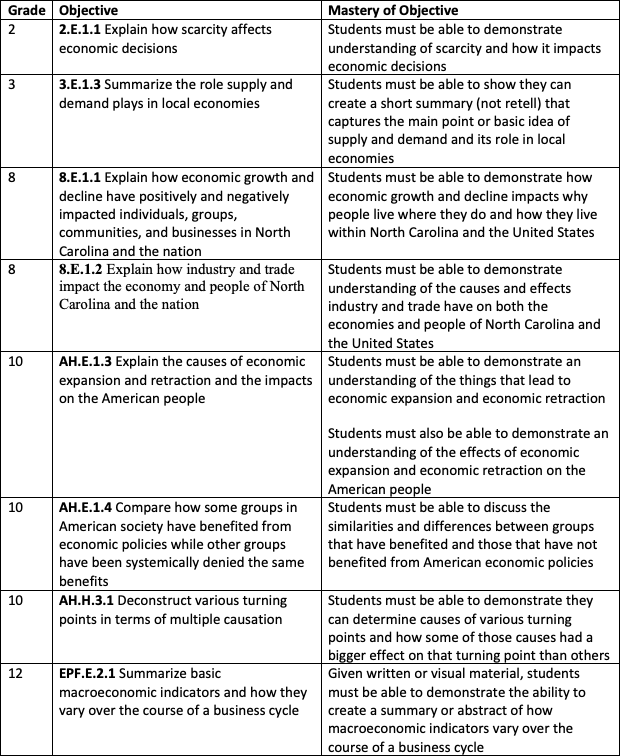As the 2022-23 school year approaches, the United States economy appears to be sliding into a recession. Unfortunately, North Carolina social studies standards offer few opportunities for students to develop the tools to think critically about the causes and effects of recessions specifically and economic phenomena generally.
How do state standards define a recession?
The North Carolina K-12 Social Studies Standard Course of Study Glossary of Instructional Terms offers two complementary definitions of economic recession:
- “An economic recession is a ‘significant decline in general economic activity in a designated region… typically recognized as two consecutive quarters of economic decline, as reflected by GDP in conjunction with monthly indicators such as a rise in unemployment.’” (Investopedia; Note that Investopedia updated the current definition on July 26, 2022, while the K-12 Social Studies Standard Course of Study Glossary cites a definition posted on June 8, 2021.)
- “An overall decline in economic activity mainly observed as a slowdown in output and employment. It is not as severe or prolonged as a depression. A recession is often defined as real GDP falling for two successive quarters, but the National Bureau of Economic Research defines a recession as ‘a significant decline in economic activity spread across the economy, lasting more than a few months, normally visible in real GDP, real income, employment, industrial production, and wholesale-retail sales’ [sic]. A recession begins just after the economy reaches a peak of activity and ends as the economy reaches its trough. Between trough and peak, the economy is in an expansion.” (Oxford Reference)
Both definitions mention the standard shorthand measure of two consecutive quarters of negative GDP growth and other measures of employment and economic output.
What do students learn about recessions and when?
State standards recommend that teachers discuss recessions in 2nd, 3rd, 8th, 10th, and 12th grades. (See Table 1.) Naturally, basic economic concepts occupy much of the focus in the elementary school grades. Unfortunately, the standards suggest that teachers link recessions to scarcity (2nd grade) and supply and demand (3rd grade). These connections will bewilder young minds, creating challenges for teachers who introduce more sophisticated economic concepts in later grades. I suspect that most elementary school educators simply avoid the subject altogether.
Table 1. North Carolina Social Studies Standards That Reference Recessions

In 8th grade, standard 8.E.1.1 requires social studies teachers to address the effects of recessions rather than their causes. Standard 8.E.1.2 makes the flawed claim that “[o]veruse of scarce resources through trade and industry may lead to economic instability, recession, or depression within a state or nation.” It ignores the role of monetary policy, political machinations, consumer sentiment, and numerous other factors that play a role.
The 10th grade American History course begins to fill in some of the blanks by stating that “[e]conomic decisions by a government as well as international events may lead to economic expansion or retraction of a nation.” Unfortunately, the acknowledgment of political factors (AH.E.1.3) appears to be in the service of teaching young adults that the economy is rigged to benefit “some at the expense of others” (AH.E.1.4) and creates “turning points” in history (AH.H.3.1). Only in the 12th-grade Economics and Personal Finance course do students begin to tackle macroeconomics in a way that would allow them to grasp the complexities of recessions.
Do public schools provide students with an adequate understanding of economics?
North Carolina does not administer a statewide social studies test, nor does it mandate that educators utilize a specific social studies curriculum. Thus, we cannot know what students know or the topics teachers choose to include or exclude from classroom instruction. Moreover, we cannot assume that educators have sufficient knowledge of economics or a desire to teach it in a way that cultivates economic thinking and an appreciation of market processes.
Parents concerned about the shortcomings of public school economics instruction should utilize excellent resources online or consider course materials available for purchase.


